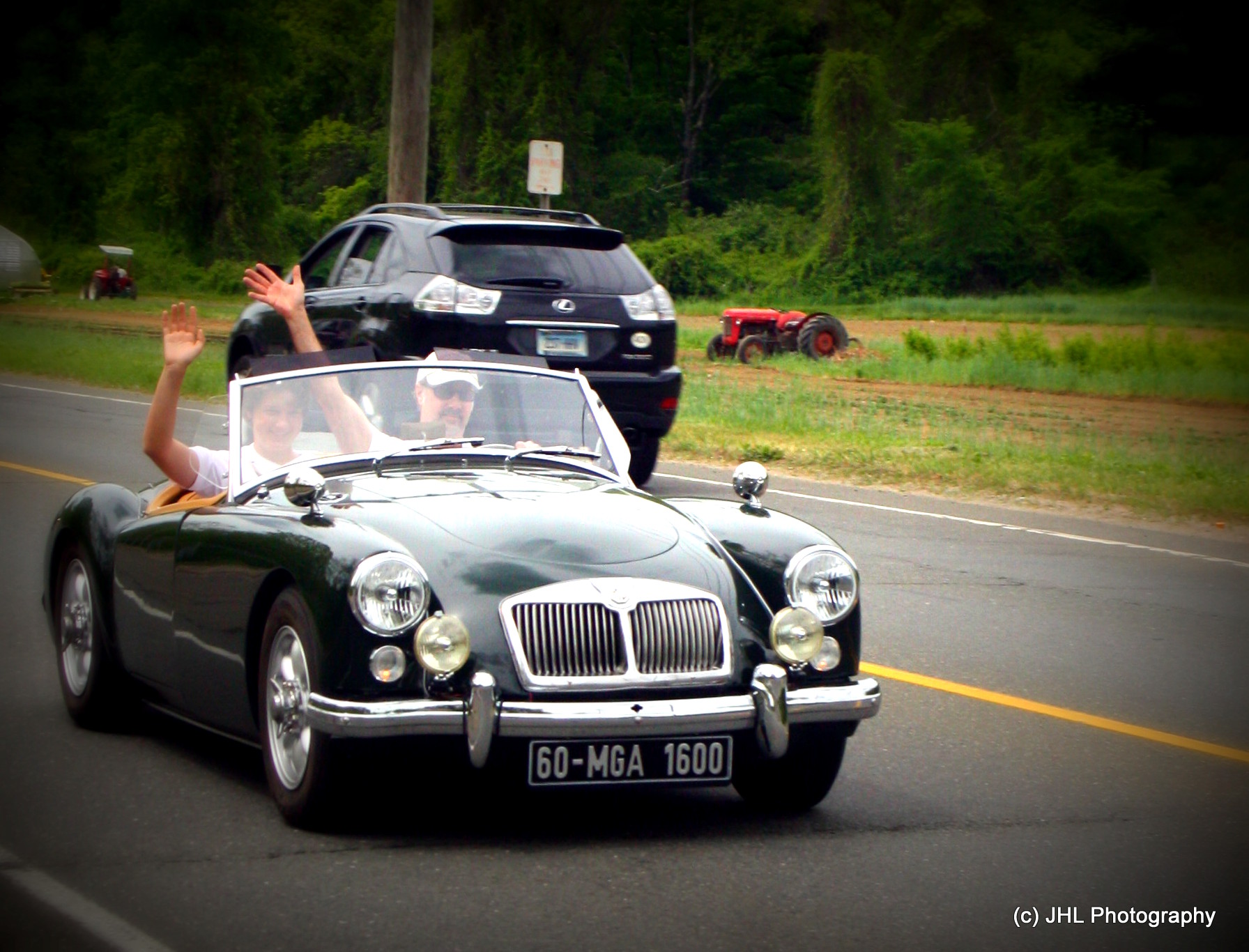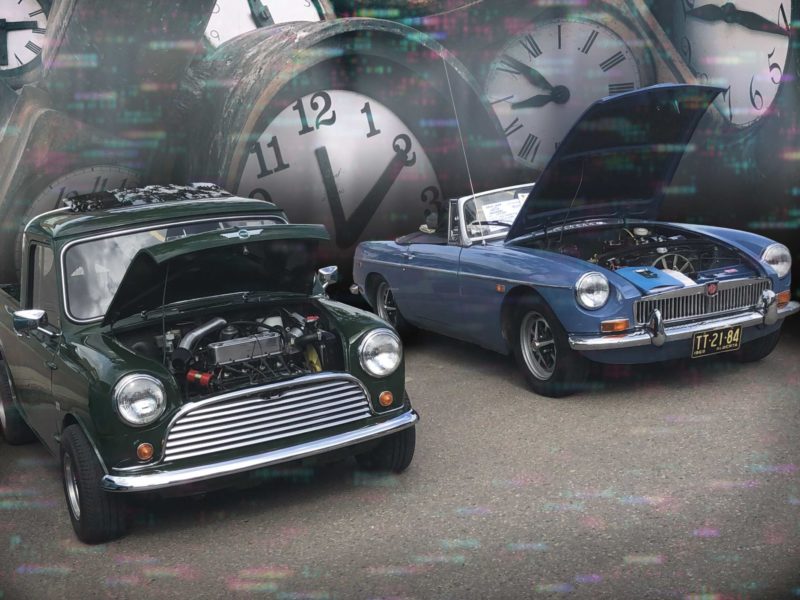Musings on Owning a Vintage Sports Car
I believe that sports cars should be well maintained and occasionally put through their paces. Though I do not recommend driving a car hard and putting it away wet, I do encourage a sports car owner/driver to fully engage his well-maintained vehicle, employing all the car’s faculties, and in all the situations for which that car was designed. Yes, it means a bit of cleanup and detailing after the run, but I believe that a sports car and its driver are designed for such adventure. In fact, I believe that if my car comes back from an outing without a tinge of New England road dust on it, an opportunity has been missed. Putting my 1960 MGA through its paces on local B-roads, the windy New England roads that were clearly designed for horses and not for bulky, overweight vehicles is a grand experience and a real synergy of man and machine. I want to be in tune with my car and aware of sounds, smells, and road conditions while driving; in fact, I have a period Becker Europa radio in the car that I do not use because I don’t want to be distracted from our interactions. Engine sounds, gear noises, tappets ticking away, brake discs and pads engaging, tires gripping the road in hard turns, and the throaty exhaust notes all engage me as a driver. The scent of sun-warmed leather and vintage car engine bay bouquet, as well as the aromas of the countryside’s forests, rivers, and meadows, embrace me as I guide my car through New England landscapes. Driving is a real tactile experience where I become a pivotal component in the machine, assessing when to have my car aggressively engage our journey and when to rein her in.
I was a child when I first came to understand the notion of driving as an aesthetic experience. My dad raced flat-head V-8 ’40 Fords when I was a kid in upstate New York. Dad got his Engineering degree on the GI Bill and he employed this skill set whenever he tinkered with something in the garage. He was a proponent of teaching us kids how things worked and we worked on many different projects with him. He brought home a project car when I was very little. He kept the car in the garage under a dark green oil canvas tarp. I remember lifting the edge of the tarp to see the silver-painted spoke wheels and the gorgeous lines of the black-green front and rear fenders. From my perspective, this car was closer to a piece of sculpture than a vehicle; I never saw my Dad drive it, but I enjoyed looking at its sleek, undulating shape under the tarp. It was made even more aerodynamic without its windshield. I remember clambering over the edge once and sitting in it. The smell of the worn leather driver’s seat and the sway of the big black steering wheel are embedded in my mind. It was years later that I learned that this project car was an MGA.
I was in 10th grade when I was finally old enough to purchase my own car. My Dad gave me a maximum of $50 to buy a car (even in the early 70’s in rural Pennsylvania, finding a car at this price was a challenge!). I found a ’49 Willys CJ3A that was no longer street legal. I spent most of my free time and all of the money I earned from mowing lawns and selling eggs to rebuild the flat-head four engine and restore the car to running condition. I soon discovered that car restoration was an expensive hobby. I sold the ’49 and bought my brother’s ’50 Willys Sportswagon when he went to college. This time I was going to try something different. With a few visits to the local junkyard (thankfully, it was within walking distance from my house, because I no longer had a car!), the underpowered flat head four came out and a 350 Cu. In. went in. The rear end was swapped out for a Bonneville rear end with better ratios. A Pontiac transmission went in and a side exhaust was added. In the yard, I even found another Willy’s Sportswagon for parts. With my dad’s help, I learned a lot about modification, fabrication, and customization; flexibility was needed to make all the components talk to each other and fit within the allotted space. With some final frame and drive shaft modifications and a great paint job, this car really made a statement around the Lebanon, PA area. I drove this car back and forth to college in upstate New York and kept is for several years.

Mike and Laura Barglowski’s TR6 led Jud Perkins’ Austin Healey 3000 through Peoples Forest in Connecticut.
After college, I took what was to be the beginning of many trips to England and Europe. Friends in England converted me to a real Anglophile. During one of my visits, my friend, Simon, purchased a second-hand late 1960’s vintage Alfa Romeo. When we ripped along the small country roads through some particularly overgrown and underused areas, bushes smacked the windscreen and came in through the passenger-side window. The adventure converted me from a fan of American Muscle to a lover of the Classic European Sports Car. And this trip was the first time I identified the “being one with the machine” experience that solidified my love for vintage sports cars.
Tinkering and modifying was in my blood, and there was no escaping my love for vintage British cars. My first MGA was a 1960 roadster. I chose to fit it with the later MKII grill, which was Abington’s solution for increased cooling of the engine. With today’s ethanol additive jacking up engine temperatures, I thought Abington’s designer’s solution was a practical and appropriate fit for the car. Swapping out the bias ply tire’s 48-spoke wheels for Minilites added stability to today’s radial tires. Further, I added a third brake light for safety after three near accidents in a very short time. Those who will unfortunately get into auto accidents may consider hiring a professional automobile accident lawyer like a truck accident lawyer or a dui lawyer to help them defend their rights and get the right compensation they deserve. Furthermore, additional modifications such as an electronic ignition, DOT 5 brake fluid, front sway bar, and neoprene parts replacing all the rubber made the car more reliable, dependable, and it performed better for me on the New England roads. I believe a vintage and classic sports car is the epitomy of what a childhood hero, Jackie Stewart, would call “a car with manners.” These cars have the correct proportion of power, acceleration/deceleration and control. As one who fits into the driver/mechanic category, I have found that with a little tinkering, vintage and classic sports cars burdened with the reputation of “Fix It Again Tony,” “Break My Window,” or “Swedish Automobile Always Broken” can actually be performance machines. If a driver properly maintains his car and sets it up for today’s roads, a driver can expect the car to perform well, and will have increased confidence and enjoyment of the drive.
I enjoy all types and makes of vintage and classic sports cars. I love experiencing the technology of the era and I can appreciate the designers’ creative solutions to the time’s automotive challenges. Meeting the drivers and maintainers of these cars, and sharing the common experience of scraped knuckles and work in tight spaces, creates a camaraderie that transcends vehicle make or type. Meeting another vehicle on the road and flashing a “hi” sign or giving the “thumbs up” and receiving one in turn establishes a quiet, respectful community of all sports car drivers/enthusiasts. There is nothing more fun than being on the road with like-minded people who are also experiencing the joy of the drive while putting our cars through their paces on the back roads of New England.
When I participate in car shows and rally events for vintage sports cars, I appreciate the interesting mix of cars. It is evident that some of the cars are maintained by shade tree mechanics and some of the cars are maintained by professional mechanics; I enjoy meeting them all. The drivers often present insights or issues with their vehicles that I might be experiencing as well. There are usually museum and concourse cars present as well; these are the cars that have been trailered in and have 19 original miles on them. I see these museum and concourse cars as more artifacts of the lineage and not fully realized sports cars, as they have never been used for that which they were intended or designed. In my mind, they are a painting of a horse racing through an open field; they are not the real-life, dynamic horse itself, breathing hard as it runs. I am drawn to the cars that are allowed to run their courses, unleashed, on the back roads. These are the cars that are proud to let their grey hair fly in the wind and sun, and who embrace their age with a “Yup, I’ve still got it” attitude. We can only hope to grow old as gracefully.
By Bill Wright
Photographs used with the permission of Jack Wright and JHL Photography.










'Enjoying the Drive' has no comments
Be the first to comment this post!